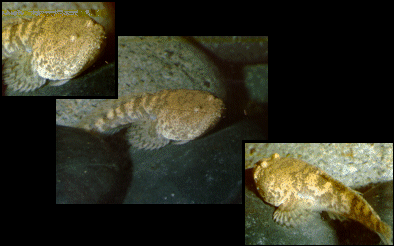









Batrachoidae or Frogfishes.
Some time ago at one of my visits to my friend Ton Cooijmans, of Tropifish at Beek en Donk he drew my attention to a number of very strange fishes, in one of the stock tanks. The fishes looked some how like frogs or better like tadpoles. The best resemblance has the big flat goggle-eyed head and the naked skin. The mouth rather wide is armed with sharp little teeth that look alike the incisive teeth of a mammal that leads to one suspect that these fishes are greedy carnivores. They also had the proportions of a strapping tadpole. But some time afterwards I came across a specimen of at least l 13 CMS.
Batrachoides
didactylus, Daector
quadrizonatus.of
Thalassophryne zonatus ?
Probably they got their name from this tadpole-like form. (Batrachos is
frog). The family of the Batrachoididae is the only family out of the order of
the Batrachoidiformes. The little first dorsale is composed of two or three shafts.
The second dorsal fin is very flexible and very long and looks alike the arsfin
The pectoral fins are well developed and the the pelvic fins that are on the throat.
The Batrachoides didactylus, that especially occurs in the eastern part
of the Atlantic Ocean is a rather ugly fish with a enormous flat head and little
eyes. The muzzle is big and the teeth consist off sharp little teeth. He also
has different appendages of the skin, specially around the mouth. The color of
the back of the fish is yellow-like with brown stripes and the belly is grayish.
In spite of the fact that this fish is innocent it is handled with care by the
fishermen because of its terrifying appearance. Much more dangerous is the specimen
Batrachoides
didactylus,
that lives near the coasts of mid and South-America. These fishes posses an effective
weapon.
The dorsal fin has namely two hollow spines that look like the teeth of poisonous
snakes. At the base of these spines is the poison gland. A bite of this fish is
very gainful: the pain can insist during hours and the heartbeat and the breathing
go slower. With the passage of time these symptoms disappear. If the wound isn't
nursed well it will fester seriously. Established is that several specimen of
the genus Thallasophryne regular intervals move from deep water to very shallow
water. That migration appears to be connected to the reproduction of these fishes
After some time they return again to deep water They are able to stay alive outside
of the water. They can during some hours in succession stay on dry land, without
they re the worse of it. In water that containing very little of oxygen, They
can normally stay alive .
Several species produce noise when they are taken
out of the water. They utter tan dull sounding noises, that generally sound like
a kind of whirring or a hoarse growling and in some cases like someone in the
distance is blowing a foghorn. This sound is so
clearly audible, because of the swimming bladder
is serving like a kind of resonance box.
Ruud Wildekamp says that in South
America, where the specimen in our pictures come from, the next species are found:
Daector quadrizonatus.
Thalassophryne zonatus in Peru, and
Thalassophryne dowi the last one by a Mr. Wilson in the Rio Truando in Colombia
in the Truando basin.
Literature:
Grzimek Het leven der dieren Utrecht,Antwerpen 1974. Blz. 458 e.v. Gunther
Sterba Enzyklopädie der Aquaristik und speziellen ichthyologie Leipzig 1977 Nieuwenhuizen,
A van den, Zoetwaterimporten Het Aquarium 1975 1976 Sterba, Gunther Enzyklopädie
der Aquaristik und speziellen ichthyologie Leipzig 1977 Lekturama Wonderen onder
de Waterspiegeldl.8 vissen Rotterdam